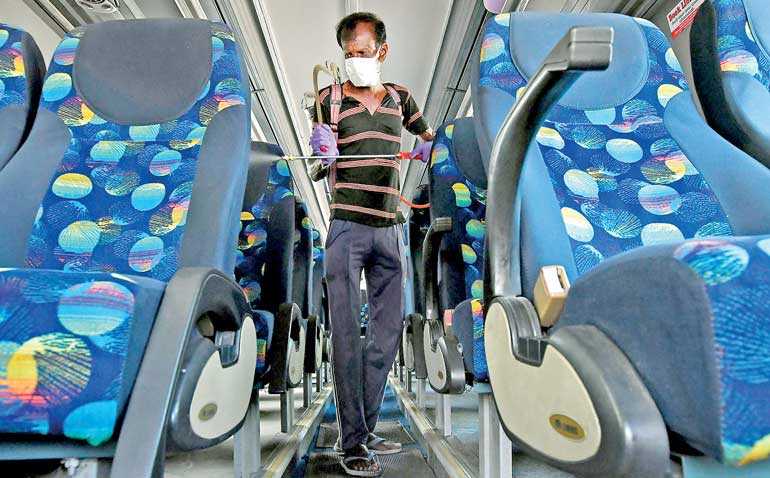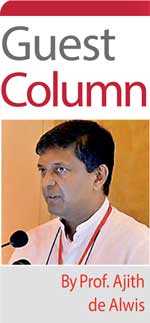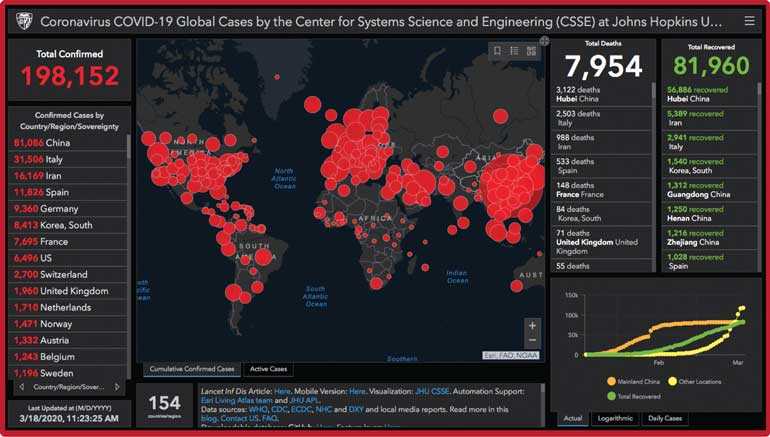Tuesday Jul 01, 2025
Tuesday Jul 01, 2025
Thursday, 19 March 2020 00:06 - - {{hitsCtrl.values.hits}}

Sri Lanka – hot and humid – battling the virus now must factor in adaptive learning and scientific decision-making. Also important would be the critical understanding of the value of research – Pic by Shehan Gunasekara
As I look at the John Hopkins University’s dashboard on COVID-19 showing the spread of this disease, you see numbers ticking almost in real time. Infected, diseased and also the recovered from this disease is displayed cumulatively and individually country by country.
You see today China being outpaced by the rest of the world. We have the scientific name for the virus, which is SARS-CoV-2 and for the disease, which is COVID-19. It was in last December that this phenomenon of the disease was noted and it is indicated that before the people on the ground seriously identified the emerging crisis, companies using AI (Artificial Intelligence), who of course map data of all types, identified unusual developments in Wuhan.
BlueDot, an AI company, was nine days ahead of WHO in flagging the issue. Metabiota and HealthMap in USA both did and the former in fact even predicted the list of countries most likely to report new cases – Italy, Iran and USA! Current records show 190,000 infected and more than 7,800 dead (which actually surpasses the entire infected in the former SARS event). 
Somewhere in Wuhan during that period the virus crossed the animal boundary to a human and that first unknown patient was set to change the life of everyone on a planetary scale – hard to comprehend with the story still unravelling but the science is stubborn. The exact pathway will never be known for certain but that it did happen that way cannot be disputed.
Of course as befits this highly-political world, a few counter theories too are around. A virus, actually a nano-sized biomaterial with a deadly potential from that transmission, has traversed the world and more than 150 countries are being affected in many ways. In the early days it was pictures of Wuhan from space that was indicated to show the effect of lockdown. Today satellite images of European cities would show similar pictures.
WHO has declared a pandemic and this is the first pandemic from a coronavirus. This virus has indeed changed the trajectory of all the inhabitants of this planet for sure. A surreal situation... No, it is for real, unfortunately. We all have to be prepared and move from a new normal yet we do not know from when. That does not mean that the virus will succeed. It may wreak havoc but still would not win finally.
Science will triumph but at what cost will ultimately be determined by the other forces that actually govern the way the knowledge will be generated and made use of. Some may act in ways opposite to what the science would demand and then the costs would be much more. Even with the situation yet to be resolved, case histories of Italy and United States would be examples.
Unravelling the mysteries of SARS-CoV-2
Researchers are working 24/7 in unravelling the mysteries of SARS-CoV-2. Some are already arming themselves to tackle the next one using the current dataset for learning!
We are living through a pandemic but with the instant ability to know what is happening. I can equally work on the actual virus or work on the genetic information uploaded on the web in planning on what to do for a vaccine.
In the US the Whitehouse Office of Science and technology Policy (OSTP) has got three institutions to set up a portal for information sharing on COVID-19. As I write this you can see 24,000 research papers collected and made available to the wider research community. Considering that for a year Sri Lanka usually publishes around 800 research papers, one can gauge the speed and the intensity of the research community in tackling this challenge. You do not have to read all 24,000 but get the IBM Watson to go through and pick ideas to trial. So with science the question really is not if but when!
It is instructive to see the research leading to insights of importance. The virus is shown to have a more penchant to infect than to kill. With children it is certainly showing a sparing behaviour. It has been shown that the virus will survive on cardboard delivery box for at least a day and lives long on steel and plastic. The fact that germs can survive on ordinary objects – Microbiologists at times take pleasure in demonstrating that the kitchen sink faucets are teaming with more germs than cistern handles of washrooms – is important knowledge. It was researchers in US who spritzed the virus on seven materials commonly found in homes and hospitals to see how long the virus remain with the potential to infect. The longest survival time was with plastic and stainless steel where they clung on for three days. The virus demonstrated the least affinity with copper with the virus gone after four hours. As an aerosol the virus remained for three hours. With the virus for the moment showing less virulence in southern latitudes the need for research under different conditions is also shown
Of the countries that can be emulated in tackling emerging issues of this nature Singapore comes on top. Singapore was on the frontline due to its proximity to China and its close integration to the world of commerce and travel.
During the times of Spanish flu the virus spread slowly as people moved slowly. Today the virus has the advantage of multiple travel options and hitching rides on all formats means the spread is fast and furious. While we ourselves created this space we must also understand the new threat once a novel virus of this nature is at play.
The science of epidemiology understands the mechanisms from growth phase to decay – the typical patterns. Understanding the patterns also with past experiences also indicates the management technique and that is the scientific approach.
All sciences together add to the knowledge that is required to handle the novel characteristics. With a novel virus of course there are always quite a lot to understand and China in a way demonstrated with precision subsequently.
Understanding your enemy
Understanding your enemy is always an essential step in fighting any war and the fight with SARS-CoV-2 is also not an exception. It is instructive however, when the enemy is not visible – something that Sun Tzu did not write about – and also has the potential to change itself with time the strategies are different. Still the basic rules of engagement apply. One difference is that the generals have to come from science!
It is instructive to see the research leading to insights of importance. The virus is shown to have a more penchant to infect than to kill. With children it is certainly showing a sparing behaviour. It has been shown that the virus will survive on cardboard delivery box for at least a day and lives long on steel and plastic.
The fact that germs can survive on ordinary objects – Microbiologists at times take pleasure in demonstrating that the kitchen sink faucets are teaming with more germs than cistern handles of washrooms – is important knowledge.

It was researchers in US – from the National Institute of Heath Virology laboratory in Montana – who spritzed the virus on seven materials commonly found in homes and hospitals to see how long the virus remain with the potential to infect. The longest survival time was with plastic and stainless steel where they clung on for three days. The virus demonstrated the least affinity with copper with the virus gone after four hours. As an aerosol the virus remained for three hours.
These experiments had been carried out with 65% relative humidity and in the temperature range of 21-23C. With the virus for the moment showing less virulence in southern latitudes the need for research under different conditions is also shown. Note that the researchers usually tackle internal problems first and issue in northern latitudes comes first. It also demonstrates the vital need to have research locally too and not have a dependency mindset.
We know that low temperatures and low humidity allows the virus to survive longer which we can be happy about. Just being happy and praying for luck is not a management technique – may be politically but not scientifically. You need to know quantitatively the picture, then you know how exactly to manage.
Really research has always been the pathway for growth. Those who managed research knowing the value that it can bring about would reap rewards. To a researcher there is a lot to study – how long the virus lasts in snot, spit, faecal matter, and on different materials and under what temperature and humidity levels. You need to track mutations as well as the virus that started its journey from Wuhan may change in Colombo.
As 24,000 research papers demonstrate in such a short time, today you will find researchers engaged in doing exactly these studies behind closed doors and inside space suits! They are unsung heroes without Oscars nor big pay checks. There are times when you pay with your life too, as we witnessed in Wuhan with the medical community.
Using the scientific approach
In using the scientific approach Singapore showed the way. It followed its usual basic principles of transparency and responses based on the power of reason over superstition and above all being scientific. With three months into this global issue these factors have been attributed to Singapore’s world-leading response to COVID-19.
It is being stated that Singapore developed the testing kits and deployed in all ports of entry. They demonstrated the protocol of determining within three hours, while individuals are quarantined on-site, officials can confirm whether or not they are infected with the virus before allowing them to enter. They also were excellent with tracking a key necessity in reducing spread. They checked well and at entry with minimal chaos and restored order. 
The story was the complete opposite in Italy and even in the USA, the super science state. Well, the issue in the USA probably can be identified to the non-scientific approach rather than to lack of science. Today we see Jack Ma tweeting pictures of sending test kits and masks to USA from China. Even having the strongest science, it perhaps was not allowed to lead in the decision-making.
‘A foreign virus from Asia cannot upset Uncle Sam’ was perhaps the dominant philosophy in the beginning. Today all 50 states in the USA are reporting infections and deaths are mounting. What the science is saying under the worst-case scenario for the USA is not pleasant to read.
The WHO Director General always spoke of the window of opportunity in controlling the spread. At one point he reiterated for those countries with less than 10 cases the situation is still positive and controllable provided the right decisions are made. The three pillars in epidemiology in management of issues of this nature are test, isolation and contact tracing. Given how effectively you can do this, you can bend the curve, shave the peak and reduce the burden. China did that very well after the initial fumbling backed by superior technology and perhaps with the single-minded focus on the result.
Singapore, understanding the emerging threat, responded scientifically with political decision making in sync with what the science recommends. When WHO stressed ‘test, test and test,’ red tape in USA bungled in testing and the first test kit made even was faulty!
It is easy to understand the importance of checking and action such as isolation when you see the multiplier effect with the ability of the virus to infect (R0 value).
COVID-19 pandemic has switched bases
The COVID-19 pandemic has switched bases. Now China is more worried about those who are coming from outside having restored within. Shanghai Disneyland has been partially reopened.
National supply chains in China have been restarted to get manufacturing back. However, many other nations are heading for lock down. Decisions had to be clinically precise to avert exponential mathematics of biological growth having a field day.
Sri Lanka – hot and humid – battling the virus now must factor in adaptive learning and scientific decision-making. Also important would be the critical understanding of the value of research. Citizenry must also be literate on the needs of the time and media should be responsible. These are anyway two ingredients for modern day living.
There are events that test the mettle of any nation and its leadership and definitely we are immersed in one! With COVID-19, science is for embracing and not for social distancing.
Discover Kapruka, the leading online shopping platform in Sri Lanka, where you can conveniently send Gifts and Flowers to your loved ones for any event including Valentine ’s Day. Explore a wide range of popular Shopping Categories on Kapruka, including Toys, Groceries, Electronics, Birthday Cakes, Fruits, Chocolates, Flower Bouquets, Clothing, Watches, Lingerie, Gift Sets and Jewellery. Also if you’re interested in selling with Kapruka, Partner Central by Kapruka is the best solution to start with. Moreover, through Kapruka Global Shop, you can also enjoy the convenience of purchasing products from renowned platforms like Amazon and eBay and have them delivered to Sri Lanka.
Discover Kapruka, the leading online shopping platform in Sri Lanka, where you can conveniently send Gifts and Flowers to your loved ones for any event including Valentine ’s Day. Explore a wide range of popular Shopping Categories on Kapruka, including Toys, Groceries, Electronics, Birthday Cakes, Fruits, Chocolates, Flower Bouquets, Clothing, Watches, Lingerie, Gift Sets and Jewellery. Also if you’re interested in selling with Kapruka, Partner Central by Kapruka is the best solution to start with. Moreover, through Kapruka Global Shop, you can also enjoy the convenience of purchasing products from renowned platforms like Amazon and eBay and have them delivered to Sri Lanka.